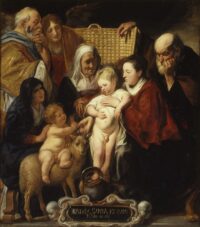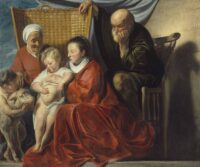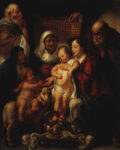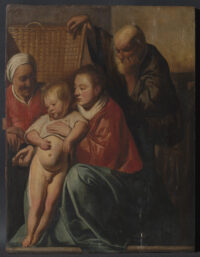 An artwork that has been hanging at the Saint-Gilles City Hall in Brussels for 60 years has been discovered to be an original work by Baroque Master Jacques Jordaens. The painting, believed to be a copy of a well-known Holy Family by Jordaens, went barely noticed on the wall of the Town Planning and Development alderman’s office until a full inventory was taken of the City Hall’s surprisingly huge art collection.
An artwork that has been hanging at the Saint-Gilles City Hall in Brussels for 60 years has been discovered to be an original work by Baroque Master Jacques Jordaens. The painting, believed to be a copy of a well-known Holy Family by Jordaens, went barely noticed on the wall of the Town Planning and Development alderman’s office until a full inventory was taken of the City Hall’s surprisingly huge art collection.
Urban.brussels, a department of the Brussels Capital Region, asked the Royal Institute for Cultural Heritage (KIK-IRPA) to take inventory of all the moveable cultural property hanging on the walls or stored in the attics at the Saint-Gilles City Hall. There are more than 800 artworks in the building and the inventory took a year. The Holy Family on the town planning office wall was attributed to a follower of Jordaens and was thought to be a copy of composition with three extant versions hanging in world-class museums (the Metropolitan Museum of New York, Saint-Petersburg’s Hermitage and the Alte Pinakothek in Munich).
As soon as the KIK-IRPA team took it down, they noticed previously-unrecorded signs that this was an original work on the back of the oak panel. In the bottom half, there is a mark of a hand — there was a second palm as part of the mark but it was covered when a new wood cradle was added to the back in the 19th century — and the castle of Antwerp, also partially obscured by the wooden reinforcements. This was the stamp of the Guild of Saint Luke of Antwerp burned into the panel with a hot iron. Next to the castle mark is a monogram GA, for Guilliam Aertssen. Aertssen was a frame and panel maker and master of the Guild of Saint Luke. He made panels for all the top artists in Antwerp, Jordaens among them. He used this style of mark between 1617 and 1623.
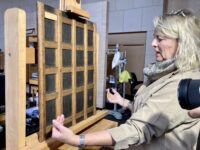 For a year, art historians and conservators studied the painting with every technique at their disposal — X-ray, IR, UV, macro-XRF imaging — and a dendrochronologist counted the growth rings visible along the edge of the panels. She found the Baltic oak tree used to make the panel was felled in 1613. The multi-disciplinary study determined that it was an original Holy Family by Jacques Jordaens, and the oldest of all the ones extant, painted ca. 1617. The analysis of the wood also found that the panel comes from the same tree used by Anthony Van Dyck in three paintings. This confirms that Van Dyck and Jordaens worked together in Rubens’ studio when they were young men, around 1617.
For a year, art historians and conservators studied the painting with every technique at their disposal — X-ray, IR, UV, macro-XRF imaging — and a dendrochronologist counted the growth rings visible along the edge of the panels. She found the Baltic oak tree used to make the panel was felled in 1613. The multi-disciplinary study determined that it was an original Holy Family by Jacques Jordaens, and the oldest of all the ones extant, painted ca. 1617. The analysis of the wood also found that the panel comes from the same tree used by Anthony Van Dyck in three paintings. This confirms that Van Dyck and Jordaens worked together in Rubens’ studio when they were young men, around 1617.
A red wax seal of the Dutch noble Schuylenburgh family that dates to the early 19th century is the earliest evidence of ownership history. In the second half of the 19th century, the panel painting entered the collection of Leopold Speekaert, a wealthy Brussels painter and collector. When he died in 1915, he left his grand mansion and art collection to the municipality of Saint-Gilles which made a museum of the mansion with all its art in 1917. A Holy Family hung in the entrance hall. It was tentatively attributed to Jacques Jordaens at that time. In 1965, the museum deemed maintenance of the house too expensive, so it was sold, demolished (sigh) and the whole art collection was moved to town hall.
The painting is in need of conservation. The varnish that has yellowed and previous touch-ups that have darkened will be removed. The back of the panel will be treated to prevent additional cracks and paint loss. Restoration complete, the Holy Family will be put on public display at the Royal Museum of Fine Arts of Belgium, home of the world’s largest collections of Jacques Jordaens.
